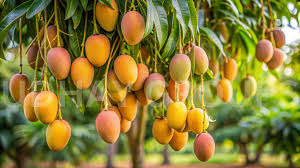Top 5 Secrets to Successful Mango Farming

Are you looking to start mango farming in India but don’t know how to do it? This guide is here to assist you.
India is the world’s largest producer of mangoes, and if you want to start mango farming, then there are many key factors that you should consider. Using the right equipment, like the SOLIS S SERIES TRACTOR or other modern farming tools, can improve your yield. However, this blog is your initial step in mango farming. We will provide a detailed guide that will help you start successful mango farming.
Why Farm Mangoes in India?
There are several reasons for farmers to start mango plantations in India; some of them include:
- Tropical climate ideal for mangoes: India has ideal weather conditions for mango farming. Warm climates with distinct wet and dry seasons help trees grow healthy and produce quality mangoes.
- Supportive government initiatives: The government offers financial support to farmers through subsidy programs and schemes. These initiatives encourage farmers to adopt modern farming methods. This reason helps increase productivity and boost farmers’ income.
- Strong domestic and overseas demand: Mangoes are in high demand both in India and abroad. They have a strong consumer base in local markets and exports.
Tips to Prepare your Land for Mango Farming
-
Terrain and Soil
Before starting mango cultivation in India, you need to make sure the terrain and soil are suitable. Choose an area that is well-drained, with a gentle slope to prevent waterlogging. The ideal soil is deep, fertile, and slightly acidic, around 6.0 to 7.5 pH. Test your soil to determine the exact pH and nutrient levels. Based on the results, you can amend the soil with organic matter or adjust the pH before planting.
-
Land Layout and Clearing
Clear your chosen land of any brush, weeds, rocks, or trees. Set up rows with a distance of 10 x 10 meters or more between mango trees to facilitate penetration of sunlight. Dig trenches 60 x 60 x 60 cm in diameter where mango saplings will be planted. Create an irrigation system and lay pipes across the rows. Leave room for roads and paths among blocks of trees.
-
Use Organic Fertilizer
Add composted cow dung or any other organic fertiliser to the tree pits before planting to fertilise the soil. Manure that has been well-rotted offers nutrients for a robust root system and good growth. You may also utilise the azotobacter activity in your mango production.
Adequate land preparation, soil conditioning, and infrastructure make the best possible environment for your mango orchard to flourish from the very beginning. Don‘t be in a hurry with this most important initial step in mango cultivation! Spending time initially will reap benefits for years to come through optimal mango yields.
3 steps to Care for Your Mango Trees
Caring for mango trees properly is essential for their health and high yields. Pay close attention to three key areas:
Watering
Water the newly grown mango trees every 2 days during the first year, especially during the summer dry season. Provide about 15-20 liters per tree.
Pruning
Prune mango trees when young to establish good structure and shape. Remove inward-facing branches, branches growing back toward the center, and any diseased wood.
Pest Control
It is a very important step to make sure that your crop is healthy and successfully grown. In the traditional method of farming, there are chemical-free pesticides available that ensure the safety of the crop.
Your trees will remain healthy and keep on producing plentiful delicious mangoes if you take good care of your farm. Allow your trees to benefit from your kind, affectionate attention.
How to Start Mango Farming in India?
Here’s a step-by-step guide for beginners to mango plantation:
Step 1: Choose the right variety of mango.
More than 1,000 varieties of mango seeds are planted in India! Choosing according to your climate and soil region. Alphonso, Dasheri, and Langra are common varieties of mangoes that are demanded according to the climate.
Step 2: Land Preparation
Proper land preparation plays an important role in ensuring successful mango farming. It is important to select a location that has well-drained soil, abundant sunlight, and good air circulation. Furthermore, before proceeding with planting, it is essential to conduct a soil test in order to assess nutrient levels and determine the pH.
Step 3: Planting Mango Trees
Once your land is ready, the next step is to plant mango saplings. First, buy mango saplings from a reliable source to avoid any diseases and help the trees grow well. However, be careful not to overwater, as mango trees don’t grow well in soggy soil.
Step 4: Care and Maintenance
Take care of your mango tree regularly for signs of pests and diseases. If you notice any issues, you can use organic or chemical pesticides and fungicides as needed. However, it is important to always follow the guidelines for safe application to ensure the health of both the tree and the environment.
Conclusion
Mango production is of concern to mango farmers because individuals only care about viewing the final part. We have demonstrated to you how mango farming can be initiated now that this detailed guide has been part of your effort with no experience required.
For enhanced productivity, using modern farming machinery like the Solis tractor can make land preparation, planting, and maintenance easier and more efficient.
So, what are you waiting for? Start your mango farming in India immediately!











